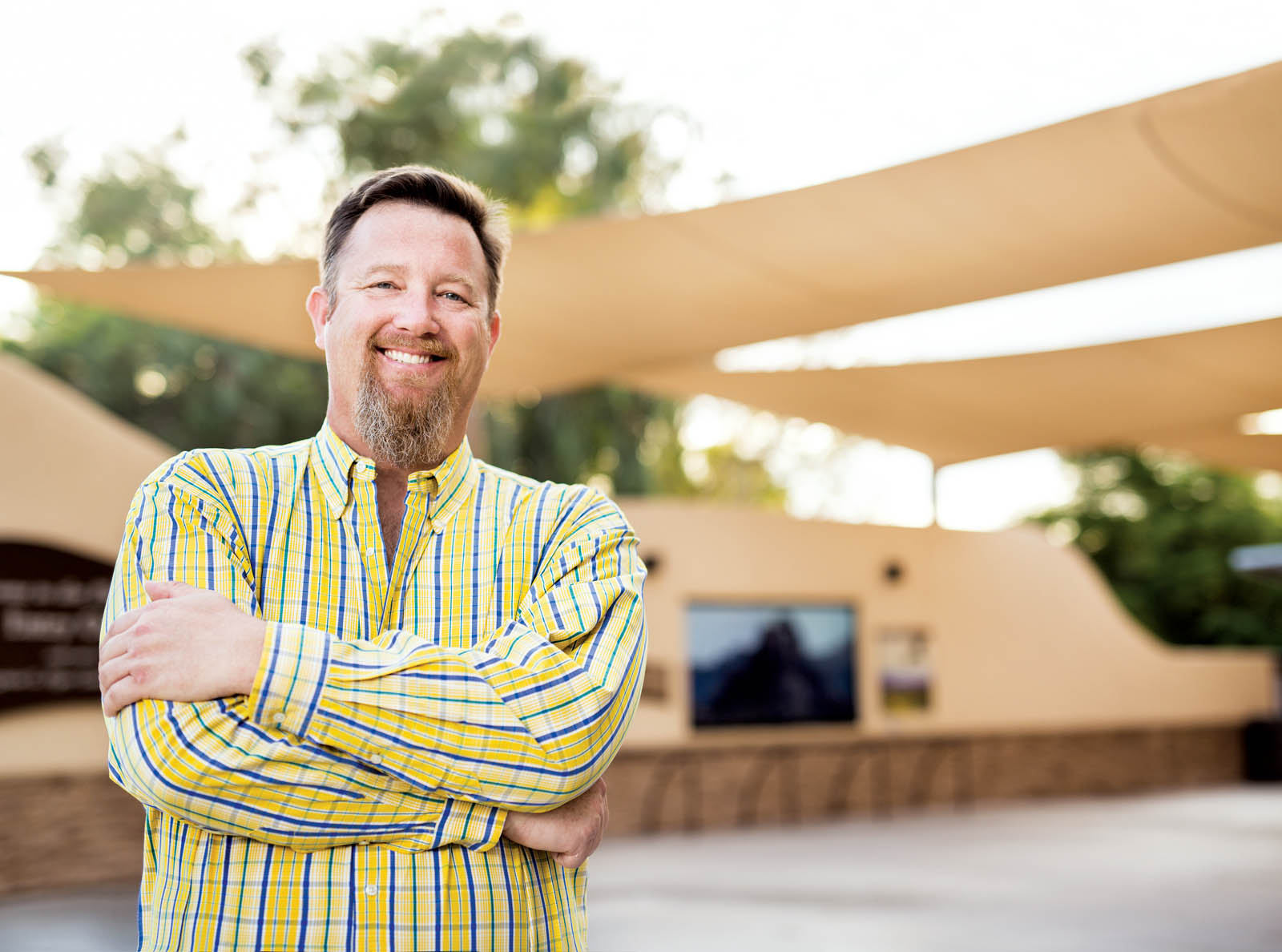
Selling shade

PHOTOS BY BRANDON SULLIVAN PHOTOGRAPHY
Conrad Masterson builds his business by focusing on what clients really want—and what employees need.
“The first thing I learned when I entered the shade sail industry was to focus on what the customer really wants,” says Conrad Masterson, president of SHADE Industries, Phoenix, Ariz. “That may sound simple, but it can be easy to lose sight of the client’s vision.”
Masterson was working as a stockbroker in 2004 when he made the decision to leave his desk job in favor of working outside, selling and installing pool barriers. It wasn’t long before he expanded the business to include selling shade sails for pools. In 2007, when the residential market took a hit, he decided to focus exclusively on selling shade. “We were already shifting away from being purely residential to doing more and more commercial projects,” Masterson says. “The shade sail business stayed together for us because it continued to be a growing industry even though construction was down.”
The company excels at providing shade solutions for commercial, industrial and residential applications, but Masterson points to the first two residential projects he worked on in 2004 as what set him up for his current success—even though both of those projects took a wrong turn and he lost money on both of them. “Neither of the projects shaded where the customers wanted,” Masterson says. “Time of day and time of year really mattered, and I didn’t take those things into account.”
In the end both projects turned out beautifully, and the customers were happy because Masterson made additions that ultimately provided shade in the way the clients wanted. But it was a challenging and costly process. “I learned from it, though,” he says. “People use areas differently than you might assume, so now we ask a lot of questions about not only what areas the client is trying to shade but also if there’s a time of day or year that is the particular focus, and how they want to use the space.”
To help determine the best placement and design for the shade structures Masterson and his team use the 3-D modeling computer program SketchUp, as well as satellite images of the project areas. “We design shade structures to complement and fit well with any existing buildings and the surroundings,” Masterson says. “Shade sails are a wonderful tool to produce shade because they lend themselves well to different shapes.”
 Selling it right
Selling it right
Focusing on achieving clients’ goals as opposed to simply making a sale is something Masterson emphasizes with his sales people. “We see it all the time—people not getting what they planned on,” he says. “So we try to achieve the client’s goals, and if for some reason we can’t do that due to something like budget or geographical constraints, we make sure the compromise is understood early on.”
If Masterson determines that the client’s needs will be met more effectively elsewhere, he recommends a different company. “We want the client to get what they need, and sometimes it becomes
clear that a typical awning will serve their needs better,” Masterson says. “It’s important to recognize when we are not their best choice.”
Talk it out
Masterson, who stands 6 foot 8 inches tall and weighs 340 pounds, refers to himself as “the biggest guy in the shade sail industry.” He says that while his company probably does more residential shade systems than any other in the area, commercial and industrial projects make up the biggest percentage of his business. And with commercial and industrial projects come bigger budgets, longer timelines and more communication and coordination challenges. “We are most often working a couple of layers deep from the owner or person who is invested in the project’s outcome,” Masterson says. “So it can be hard to get clarity and consensus on what people want and need.”
 He relies on continuing to ask questions of all parties involved. “I try to get the clients to spend a decent amount of time talking about their goals,” he says. “It may not seem like an important conversation to them at the time, but it saves time down the road.”
He relies on continuing to ask questions of all parties involved. “I try to get the clients to spend a decent amount of time talking about their goals,” he says. “It may not seem like an important conversation to them at the time, but it saves time down the road.”
Although he relies on email strings for some communication, Masterson says there’s no substitute for face-to-face or phone conversations. “For some projects it seems like the client and I can go back and forth via text or email for three or four days and still not have clarity,” he says. “But we can talk on the phone and in minutes we’re going the right direction.”
Masterson encourages his sales people to forgo text and email in favor of face-to-face or phone communication as well. “I’m constantly reminding them it’s not as effective to try to sell using email,” he says. “It just cuts through a lot of assumptions when you can talk to somebody.”
A focus on revenue
Selling more projects and/or selling bigger projects is more of a focus for Masterson than bringing down costs. “Expenses need to be managed, but I don’t look at those things nearly as often as I look at trying to sell more,” he says. “You can only reduce costs to a certain amount, but there is no limit to how much you can sell.”
A firm believer in using commissions to motivate sales staff, Masterson finds that it’s best to provide base pay as well. “In the first years our sales people worked on commission only, but that was tough when there were dry spells. It didn’t mean they weren’t still working hard, so we added a base pay,” he says. “It can be especially difficult for sales people when they first start out in this industry—some projects take months or even years to close.”
Increasing sales each year isn’t the only goal Masterson sets: he also looks for ways to improve projects’ design, materials and execution, as well as how to make his company a better place to work. This year he added two holidays and increased the insurance reimbursement for employees. “I was an employee for a long time and I understand how important it is to be paid well and get holidays,” Masterson says. “It can’t be all about keeping costs down.”
For clients as well as employees, Masterson’s approach is the same. He tries to make projects bigger and nicer as opposed to smaller and cheaper, and he tries to make his company a better place to work by focusing on growth instead of focusing on cutting costs.










